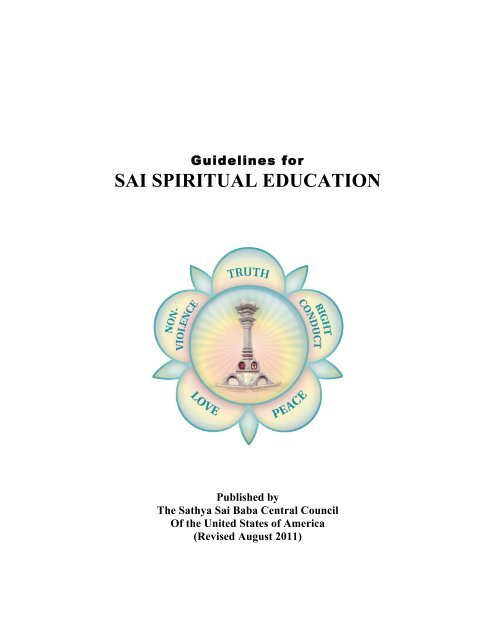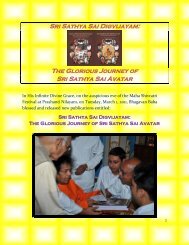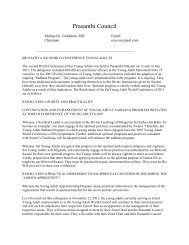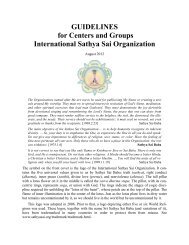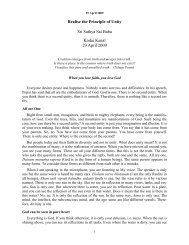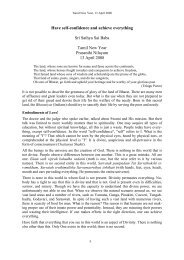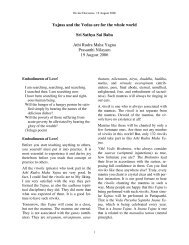Guidelines for the SSE Program - USA Sai Organization
Guidelines for the SSE Program - USA Sai Organization
Guidelines for the SSE Program - USA Sai Organization
Create successful ePaper yourself
Turn your PDF publications into a flip-book with our unique Google optimized e-Paper software.
<strong>Guidelines</strong> <strong>for</strong>SAI SPIRITUAL EDUCATIONPublished byThe Sathya <strong>Sai</strong> Baba Central CouncilOf <strong>the</strong> United States of America(Revised August 2011)
Table of Contents I. <strong>Organization</strong>al Structure of <strong>the</strong> <strong>Sai</strong> Spiritual Education <strong>Program</strong> of <strong>the</strong> <strong>USA</strong> ... 1A. The <strong>Sai</strong> Spiritual Education (<strong>SSE</strong>) <strong>Program</strong> ................................................................ 1B. The <strong>SSE</strong> Teacher ........................................................................................................ 1C. The Center Education Coordinator .............................................................................. 1D. The Regional Education Coordinator .......................................................................... 2E. The National Education Coordinator ........................................................................... 2F. The Center and Center President ................................................................................ 2II. <strong>Sai</strong> Spiritual Education <strong>Program</strong> of <strong>the</strong> <strong>USA</strong> .................................................. 4A. Groups I, II, III and IV .................................................................................................. 41. Spiritual Objectives by Age Groups ....................................................................................... 42. The Group I (Ages 6, 7, 8; Grades 1, 2, 3) ............................................................................ 44. The Group III (Ages 12, 13, 14; Grades 7, 8, 9) .................................................................... 55. The Group IV (Ages 15, 16, 17; Grades 10, 11, 12) .............................................................. 5B. The Curriculum ............................................................................................................ 6III. Parental Involvement and Parent Groups ...................................................... 8A. Purpose, Goals and Objectives ................................................................................... 8B. Structure, Format and Procedure ................................................................................ 8C. Mutual Commitment and Responsibilities of <strong>SSE</strong> Teachers and Parents ................... 9IV. Education, Training and Support <strong>for</strong> <strong>SSE</strong> Teachers .................................... 10A. Training <strong>Guidelines</strong> <strong>for</strong> New Teachers: A total of four days training ......................... 10B. Training <strong>Guidelines</strong> <strong>for</strong> All Teachers ......................................................................... 10C. Supportive Activities and Resources ......................................................................... 11D. Problem-solving Procedure ....................................................................................... 11Step 1: ..................................................................................................................................... 11Step 2: ..................................................................................................................................... 11Step 3: ..................................................................................................................................... 11Step 4: ..................................................................................................................................... 11Step 5: ..................................................................................................................................... 11i
D. The Regional Education CoordinatorYou are just a coordinator <strong>for</strong> name's sake only. All are servants. You are aservant of a master, that's all. When <strong>the</strong> master servant leads, o<strong>the</strong>rs follow.Sri Sathya <strong>Sai</strong> BabaOverseas Office Bearers Conference, November 20, 19921. Supports <strong>the</strong> region with <strong>SSE</strong> teacher training classes as needed.2. Organizes a minimum of two enrichment workshops <strong>for</strong> <strong>SSE</strong> teachers each year.3. Communicates national in<strong>for</strong>mation on <strong>SSE</strong> to Center Education Coordinators,Center Presidents and <strong>the</strong> Regional President.4. Works cooperatively with <strong>the</strong> regional officers in all areas of concern within <strong>the</strong>region.5. Supports, guides and inspires all <strong>the</strong> Center <strong>SSE</strong> programs, including retreats/conferences,Sathya <strong>Sai</strong> Birthday celebrations and Children’s Day (EaswaramaDay).E. The National Education CoordinatorDo not seek to exercise authority over o<strong>the</strong>rs, seek ra<strong>the</strong>r to discover chancesto be useful to <strong>the</strong>m. When you neglect your duty, <strong>the</strong> positions of authoritystart causing headaches.Sri Sathya <strong>Sai</strong> BabaOverseas Office Bearers Conference, November 20, 19921. Communicates national news such as teacher trainings, workshops and new materialsto <strong>the</strong> Regional Coordinators and <strong>the</strong> President of <strong>the</strong> Sathya <strong>Sai</strong> Baba CentralCouncil.2. Is responsible <strong>for</strong> collecting materials <strong>for</strong> <strong>the</strong> <strong>SSE</strong> curriculum.3. Helps provide spiritual solutions to problems that might arise in any of <strong>the</strong> regionalareas.4. As a member of <strong>the</strong> Sathya <strong>Sai</strong> Council of America, attends all meetings, keeping<strong>the</strong> Council in<strong>for</strong>med as to <strong>the</strong> progress of <strong>the</strong> <strong>SSE</strong> <strong>Program</strong>.5. Provides support to all ten regions with teacher trainings, new materials, problemsolving etc., as <strong>the</strong> needs arise.F. The Center and Center PresidentThis organization was started to enable man to lead an ideal life andbring about a trans<strong>for</strong>mation in society. There are two factors that can ruinan individual. The first is ego; <strong>the</strong> o<strong>the</strong>r jealousy. Jealousy is a pest andego a harmful insect. Both can kill a plant. In <strong>the</strong> tree of human life, jealousyworks from inside, and <strong>the</strong> human quality is hidden. There<strong>for</strong>e, in ourorganization, we should be far away from ego and jealousy and cultivate abroad mind.Sri Sathya <strong>Sai</strong> BabaOverseas Office Bearers Conference, November 20, 19922
C. Mutual Commitment and Responsibilities of <strong>SSE</strong> Teachers and ParentsParents and teachers have a duty to see that children are brought upalong right lines through love, precept and if necessary, correctivemeasures…It is because parents and teachers fail to en<strong>for</strong>ce disciplinethat students behave in <strong>the</strong> most irresponsible ways and indulge in disorderand violence.Sri Sathya <strong>Sai</strong> BabaSanathana Sarathi, March 1984, page 621. The teacher shall provide a spiritual and experiential educational program throughwhich <strong>the</strong> child may develop <strong>the</strong>ir divine human nature, following <strong>the</strong> guidelinesof <strong>the</strong> <strong>SSE</strong> program in cooperation with <strong>the</strong> Sathya <strong>Sai</strong> Center.2. The parent agrees to rein<strong>for</strong>ce <strong>the</strong> goals and objectives of <strong>the</strong> <strong>SSE</strong> program in <strong>the</strong>home, to see that <strong>the</strong> <strong>SSE</strong> student attends regularly and to participate as often aspossible in regularly scheduled <strong>SSE</strong> activities.3. The parent is invited to arrange with <strong>the</strong> <strong>SSE</strong> teacher occasional visits to <strong>the</strong> <strong>SSE</strong>Class.4. Teachers meet with parents to discuss <strong>the</strong>ir child's progress.5. Teachers should regularly in<strong>for</strong>m parents about <strong>the</strong> goals and objectives <strong>for</strong> <strong>the</strong>class through lesson plans, written communications or any o<strong>the</strong>r means that ismutually acceptable to teacher and parent.9
IV.Education, Training and Support<strong>for</strong> <strong>SSE</strong> TeachersThe teacher has <strong>the</strong> greatest role in molding <strong>the</strong> future of <strong>the</strong> country. Ofall professions, teaching is <strong>the</strong> noblest, <strong>the</strong> most difficult, and <strong>the</strong> most important.The teacher should be an example to <strong>the</strong> pupils. If a teacher has avice, thousands are polluted. If <strong>the</strong> teacher is dedicated and pure, thousandsof children will be improved and <strong>the</strong> nation will gain from educatedmen and women of character.Sri Sathya <strong>Sai</strong> BabaTeacher Training Camp, Prasanthi Nilayam, August 1983A. Training <strong>Guidelines</strong> <strong>for</strong> New Teachers: A total of four days training1. The teacher training should be offered each year and should reflect <strong>the</strong> needs and<strong>for</strong>mat of all four group levels.2. New teachers should attend a two-day teacher training on <strong>the</strong> basic principles of<strong>Sai</strong> Education. Where it is not possible to conduct <strong>the</strong> first basic training on twoconsecutive days, <strong>the</strong>y may be divided into two separate days, but both shouldprecede <strong>the</strong> two enrichment workshops.3. New teachers should attend two subsequent “enrichment” workshops during <strong>the</strong>year. These workshops should focus on additional teaching techniques and materialsto be used in <strong>the</strong> <strong>SSE</strong> Classes.4. New teachers should observe and assist a veteran teacher with a class <strong>for</strong> at leastfour to six sessions be<strong>for</strong>e beginning to teach.5. A new teacher should be assisted, when possible, by a veteran teacher as a mentor<strong>for</strong> <strong>the</strong> first year of teaching.6. New teachers should periodically observe classes on each of <strong>the</strong> four group levels.7. A certificate of completion should be issued by <strong>the</strong> Regional Education Coordinatorindicating attendance at <strong>the</strong> teacher training and <strong>the</strong> two enrichment workshops.8. Substitute teachers should complete <strong>the</strong> same course as <strong>the</strong> new teacher.B. Training <strong>Guidelines</strong> <strong>for</strong> All Teachers1. Teachers should attend <strong>the</strong> two “enrichment” trainings offered each year (<strong>the</strong>seare <strong>the</strong> same additional days that new teachers attend).2. Teachers should continue to observe classes at all four group levels.3. Teachers should work collaboratively, as needed, with <strong>the</strong> Center Education Coordinator.10
C. Supportive Activities and Resources1. There should be monthly meetings to promote open communication betweenteachers and <strong>the</strong> Center Education Coordinator to share ideas, successes, concerns,plans, etc.2. Resources available are publications such as <strong>the</strong> Sanathana Sarathi, Sathya <strong>Sai</strong>Newsletter <strong>USA</strong>, lesson plans, audio and videos.D. Problem-solving ProcedureIf two teachers quarrel or become unfriendly, both should be removed. Noinquiry is necessary; we condemn both <strong>for</strong> having been involved. One poisonousinsect can destroy an entire crop.Sri Sathya <strong>Sai</strong> BabaTeacher Training Camp, Prasanthi Nilayam, August 1983Step 1: The teacher discusses <strong>the</strong> problem with <strong>the</strong> individuals who are directly involved tofind harmonious resolution.Step 2: The Center Education Coordinator is consulted, if necessary, and communication iscontinued until <strong>the</strong>re is harmonious resolution.Step 3: The Center President may be requested to assist, etc.Step 4: The Regional Education Coordinator is consulted and brings <strong>the</strong> matter to <strong>the</strong> attentionof <strong>the</strong> Regional President.Step 5: The National Education Coordinator is consulted and brings <strong>the</strong> matter to <strong>the</strong> attentionof <strong>the</strong> National President.11


